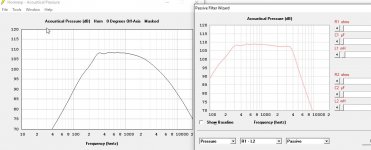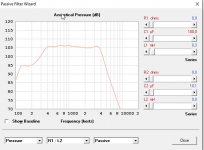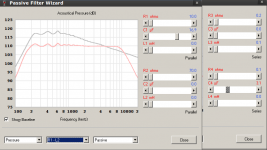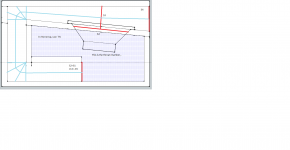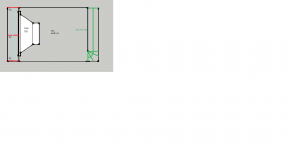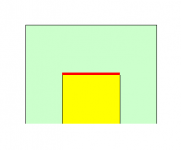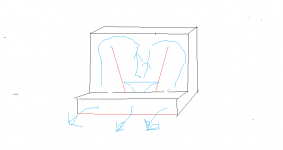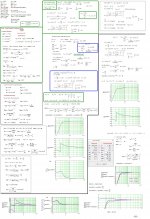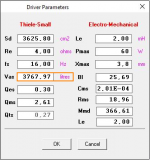Hi David.
My knowledge about speakers is not that high so I have a question why with a low pass filter the gractrix horen extens so much and get very nice respons.
Maybe it comes because of kind of filter Cheybyscheff action, will give fase errors thougth.
thanks
kees
My knowledge about speakers is not that high so I have a question why with a low pass filter the gractrix horen extens so much and get very nice respons.
Maybe it comes because of kind of filter Cheybyscheff action, will give fase errors thougth.
thanks
kees
Attachments
Last edited:
My knowledge about speakers is not that high so I have a question why with a low pass filter the gractrix horen extens so much and get very nice respons.
Hi Kees,
It is difficult to provide a definitive comment without knowing the actual input parameter values for the loudspeaker system in question. I am however reasonably confident that the simulation results are being correctly calculated. Note that if the same passive filter network is applied to the default record, the effect on the response is quite different. This is because the speaker frequency-dependent electrical input impedance loading the filter network is different.
Kind regards,
David
So I'm probably just lacking the correct search-term, but how would these cabinets be modeled in HR:
1) A "Quasi-6th Order Series-Tuned BP" as seen on this page: Hornresp for Dum... hmm... Everyone - Page 2 - Home Theater Forum and Systems - HomeTheaterShack.com - post 14:
- Page 2 - Home Theater Forum and Systems - HomeTheaterShack.com - post 14:
I cannot figure out if I'm using HR incorrect, but on the example from in the post there is "Ap1 and Lpt" . On my copy of Hornresp (39.40) I have "Ap1 and Lp" or "Ap and Lpt". That is: I cannot get Ap1 and Lpt at the same time?
2) A BR with a "slot-loading" on the driver-surface:
I can figure out hos to do the right side (BR-part), but I'm not sure how to model the loading with slot on driver.
Kind Regards and thanking for a super tool!
TroelsM
1) A "Quasi-6th Order Series-Tuned BP" as seen on this page: Hornresp for Dum... hmm... Everyone
An externally hosted image should be here but it was not working when we last tested it.
I cannot figure out if I'm using HR incorrect, but on the example from in the post there is "Ap1 and Lpt" . On my copy of Hornresp (39.40) I have "Ap1 and Lp" or "Ap and Lpt". That is: I cannot get Ap1 and Lpt at the same time?
2) A BR with a "slot-loading" on the driver-surface:
An externally hosted image should be here but it was not working when we last tested it.
I can figure out hos to do the right side (BR-part), but I'm not sure how to model the loading with slot on driver.
Kind Regards and thanking for a super tool!
TroelsM
Hi David.
My knowledge about speakers is not that high so I have a question why with a low pass filter the gractrix horen extens so much and get very nice respons.
Maybe it comes because of kind of filter Cheybyscheff action, will give fase errors thougth.
thanks
kees
Indeed...tweaking a bit more like you with passive network on a Tangband w4-1320si high way unity horn to get flat response. This little trick help a lot, probably with less compromise than a high ratio compression chamber/phase plug. The higher the frequency, the harder it is to get horn boost effect. So + 3db at 8khz is just good enough for me, and the on axis roll off is perfect for crossing with a jbl st200 bullet tweeter (at horn mouth), it looks to be 3th order.
At start, i thought only about active and natural crossover (natural for 4th bandpass loading filter effect + inductance of woofer) for this project but here it became a bit more crazy again with a bit of passive crossover. With it easy wizard, hornresp again helps trying stuff i don't even understand ^^ Again, hornresp is really powerful and fun to play with, thanks David !
Damien
Attachments
Last edited:
So I'm probably just lacking the correct search-term, but how would these cabinets be modeled in HR:
1) A "Quasi-6th Order Series-Tuned BP" as seen on this page:
I cannot figure out if I'm using HR incorrect, but on the example from in the post there is "Ap1 and Lpt" . On my copy of Hornresp (39.40) I have "Ap1 and Lp" or "Ap and Lpt". That is: I cannot get Ap1 and Lpt at the same time?
2) A BR with a "slot-loading" on the driver-surface:
I can figure out hos to do the right side (BR-part), but I'm not sure how to model the loading with slot on driver.
Kind Regards and thanking for a super tool!
TroelsM
I can't say that I am doing this correctly, but when I recently simulated such a cabinet, I approached it as a tapped horn with a large throat chamber. The throat chamber volume is the reflex cabinet, the "horn" forms the port, and the tap places the driver inside the port. I didn't use Apt/Lpt at all.
Unfortunately, my prototype #1 of this cabinet didn't quite live up to the predictions, though I expect that much of that was my failure in translating what I modeled into the cabinet I built.
On my copy of Hornresp (39.40) I have "Ap1 and Lp" or "Ap and Lpt". That is: I cannot get Ap1 and Lpt at the same time?
Hi TroelsM,
See post linked below:
http://www.diyaudio.com/forums/mult...-bandpass-mid-unity-horn-201.html#post4684285
If you are currently using Version 39.40, perhaps its time to update to the latest release
Kind regards,
David
Thanks for the reply. I didnt think about that it could be related to the version.
Once again: thanks for the great tool.
Kind regards TroelsM
David has this wonderful habit of improving the program.
It is very advantageous to keep downloading the updates as there are many options that are added or improved.
Hi All
Since the forum is quiet I have a NB question. I have a ev30 with a fs 0f 16 hz. I have an area of 3meters by 3meters vertical by 1 meter to build a tapped horn. The bottom 1 x 3 meters would be the mouth which could be extended out into my listening room. My idea is to have the speaker on its back in the middle firing up directly into the beginning of the first section, with the back firing down into the middle of the mouth. At the top of the enclosure the path would split and come back down either side of the center section exiting left and right of the center where the rear of speaker would be firing. Can I model this in hornresp and what would I call it.
Thanks for any help
Mike
Fs = 16 Hz
Qes = .3
Qms = 2.61
Qts = .27
Vas = 210 sq ft 5,946.54 liters
no = 5 percent
Vd = 84.3 sq in 543.87 sq cent
Sd = 562 sq in 3,625.80 square centimeter
Xmax = .15 in 3.81 millimeters.
Pe (max) 60 watts
Zmax = 8 ohms
Re = 4 ohms
Since the forum is quiet I have a NB question. I have a ev30 with a fs 0f 16 hz. I have an area of 3meters by 3meters vertical by 1 meter to build a tapped horn. The bottom 1 x 3 meters would be the mouth which could be extended out into my listening room. My idea is to have the speaker on its back in the middle firing up directly into the beginning of the first section, with the back firing down into the middle of the mouth. At the top of the enclosure the path would split and come back down either side of the center section exiting left and right of the center where the rear of speaker would be firing. Can I model this in hornresp and what would I call it.
Thanks for any help
Mike
Fs = 16 Hz
Qes = .3
Qms = 2.61
Qts = .27
Vas = 210 sq ft 5,946.54 liters
no = 5 percent
Vd = 84.3 sq in 543.87 sq cent
Sd = 562 sq in 3,625.80 square centimeter
Xmax = .15 in 3.81 millimeters.
Pe (max) 60 watts
Zmax = 8 ohms
Re = 4 ohms
Hi Angelow,
Yes.
I am not exactly sure how to interpret your description of the proposed system, but if the two acoustic paths are configured as shown in the attachment, then it would be a compound horn (CH) with one horn folded and bifurcated, rather than a tapped horn.
Would it be possible for you to post a drawing of the proposed layout to make things a bit clearer?
Kind regards,
David
Can I model this in hornresp
Yes.
what would I call it.
I am not exactly sure how to interpret your description of the proposed system, but if the two acoustic paths are configured as shown in the attachment, then it would be a compound horn (CH) with one horn folded and bifurcated, rather than a tapped horn.
Would it be possible for you to post a drawing of the proposed layout to make things a bit clearer?
Kind regards,
David
Attachments
bjorno
I am totally in the dark with all the algebra, although in grade 9 I was the go to kid. As the saying goes, "you don't use it you lose it", and 45 years later I can't solve for x. But even if get my math at least functioning....I am lost with all your parameters. I see you changed the vas, I'll use that from now on. I measured the le with my muti meter and got .94mh...don't now if that makes a difference in your calculations...and then again that might not be the true le. The horn you have given exceeds the drivers xmax, and due to the age of the driver, although it appears in wonderful shape, being in church all its life...ha...ha, that was why I wanted to go the horn route...so it wouldn't have to work so hard. I am pretty confident how to bend the horn without affecting its length, but to be able to get a design to growl without to much effort...well you know...heaven. The left and right sides of the mouth would be flanked by two baffles with jbl 145s, so this might help loading . These baffles would go to the adjoining walls at 30 degree angles or so, as the room is 20 feet wide by 10 feet high by 40 feet long.
Thanks for your imput
Mike
I am totally in the dark with all the algebra, although in grade 9 I was the go to kid. As the saying goes, "you don't use it you lose it", and 45 years later I can't solve for x. But even if get my math at least functioning....I am lost with all your parameters. I see you changed the vas, I'll use that from now on. I measured the le with my muti meter and got .94mh...don't now if that makes a difference in your calculations...and then again that might not be the true le. The horn you have given exceeds the drivers xmax, and due to the age of the driver, although it appears in wonderful shape, being in church all its life...ha...ha, that was why I wanted to go the horn route...so it wouldn't have to work so hard. I am pretty confident how to bend the horn without affecting its length, but to be able to get a design to growl without to much effort...well you know...heaven. The left and right sides of the mouth would be flanked by two baffles with jbl 145s, so this might help loading . These baffles would go to the adjoining walls at 30 degree angles or so, as the room is 20 feet wide by 10 feet high by 40 feet long.
Thanks for your imput
Mike
- Home
- Loudspeakers
- Subwoofers
- Hornresp
